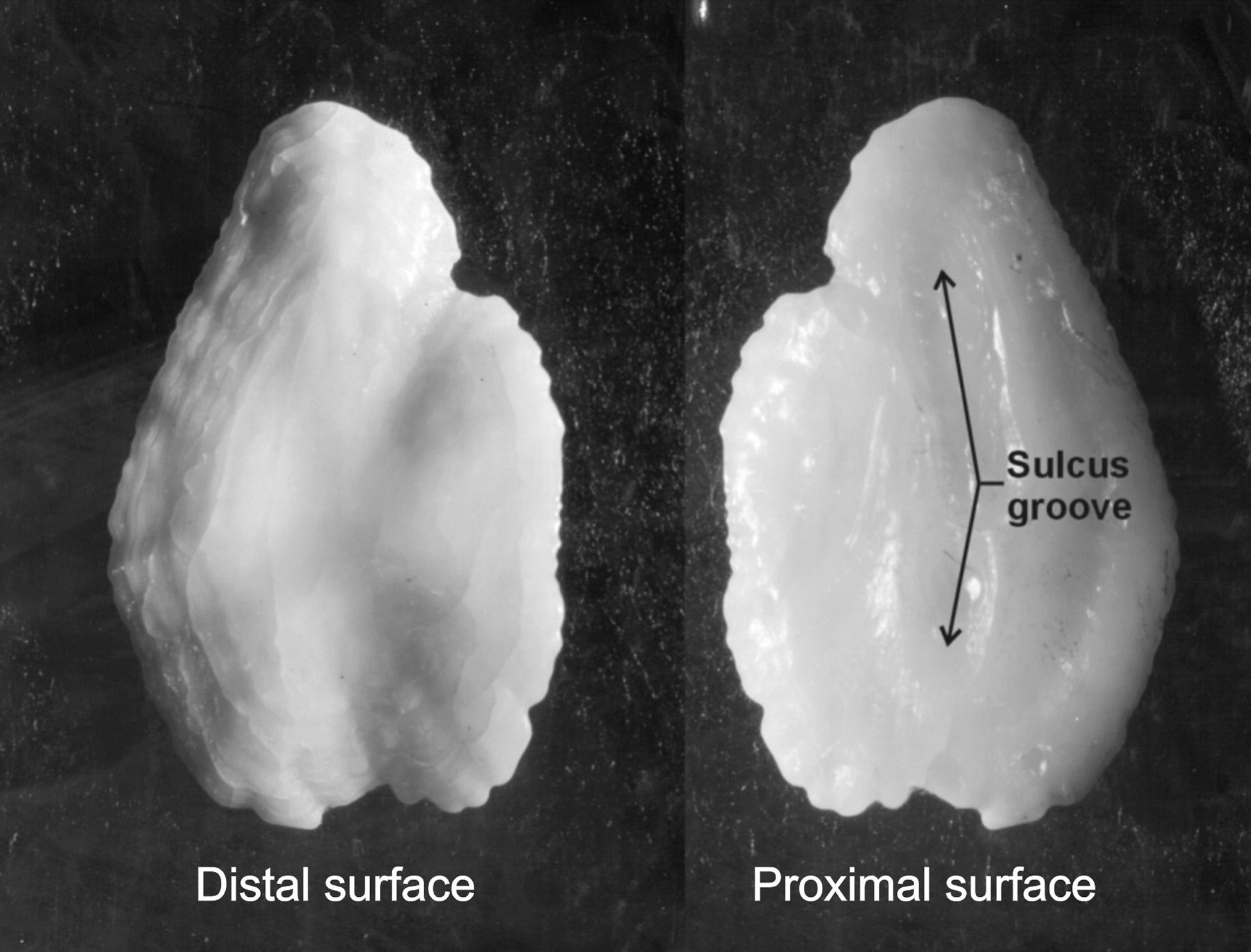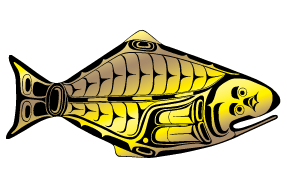Otoliths, also called ear-bones, are structures made primarily of calcium carbonate that are found in the head of most fish. Otoliths act as sound receptors and also play a role in balance and orientation. As the fish grows, so does the otolith, by deposition of concentric layers of material (Figure 1). Seasonal changes in the fish’s growth rate are reflected in the otolith. A year’s growth consists of a wider summer zone (reflecting faster growth) and a narrower winter zone (reflecting slower growth). Because halibut spawn in winter, the winter zones are counted to determine the age of the fish in years. These annual growth rings, or “annuli”, are similar in appearance to the growth rings of trees.

Figure 1. Cross-sections of an otolith.
Otoliths, also called ear-bones, are structures made primarily of calcium carbonate that are found in the head of most fish. Otoliths act as sound receptors and also play a role in balance and orientation. As the fish grows, so does the otolith, by deposition of concentric layers of material (Figure 1). Seasonal changes in the fish’s growth rate are reflected in the otolith. A year’s growth consists of a wider summer zone (reflecting faster growth) and a narrower winter zone (reflecting slower growth). Because halibut spawn in winter, the winter zones are counted to determine the age of the fish in years. These annual growth rings, or “annuli”, are similar in appearance to the growth rings of trees.

Figure 2. Eyed and blind side otoliths.
Pacific halibut actually have six otoliths, three on each side of the head, and the IPHC uses for ageing the largest of these called the sagittal otoliths. Only the blind-side otolith is used for production aging. The eyed- and blind-side otoliths (Figure 2) are not mirror images in Pacific halibut as they are in some species, and the growth patterns on eyed-side otoliths are more difficult to interpret. Pacific halibut otoliths are cleared in 50% glycerin solution for several weeks and then viewed under reflected light using dissecting microscopes at a magnification between 5X and 50X. Aging methods used at the IPHC include the following:
- Surface ageing: Otoliths are read while immersed in water over a dark background (to minimize glare from the light source and maximize contrast). The distal surface (Figure 3) of the otolith is observed during surface reads; the proximal surface (flip side of the otolith) has a deep groove and annuli are obscured.

Figure 3. The front and back of an otolith.
-
- Break-and-bake aging: Break-and-bake involves scoring the otolith surface through the nucleus with a razor blade, snapping the otolith in half (Figure 4) and baking it in a toaster oven at 500°F. Only one of the halves is baked so that a surface reading can still be made on the unbaked half if desired. Baking the sections enhances the contrast between summer and winter zones (winter zones turn dark brown). Previously the otolith sections were heated one at a time over an alcohol flame (break-and-burn); however, baking allows readers to heat many sections at a time, and is thus much more efficient (Figure 5). The baked sections are then mounted in modelling clay and either coated with liquid (mineral oil or glycerin solution) or immersed in water before viewing under the microscope.

Figure 4. A broken and baked otolith cross-section of an 8-year old fish.

Figure 5. Using a toaster oven to bake several otoliths at a time
Through 2001, Pacific halibut otoliths were all surface aged at the IPHC. The criteria used between 1992 and 2001 included performing break-and-burn or break-and-bake age determinations in cases where readers were not confident of the surface age, (e.g. thick/steep edge, opaque or cloudy surface, odd growth pattern, high surface age, etc.). The break-and-burn/bake method of age determination was validated by a bomb radiocarbon study (Piner and Wischniowski 2004) and since 2002, all longline (survey and commercial) and recreationally-caught halibut are aged by break-and-bake technique. Surface patterns on very young Pacific halibut, commonly caught during the NOAA Fisheries groundfish trawl surveys, are clearer and easier to interpret, and yield the same ages as the break-and-bake method for Pacific halibut younger than five years old. Since 2002, if the surface age is five or greater, the otolith is broken and baked. Trawl survey-caught otoliths that are obviously older than five are not surface-aged first.
The oldest age recorded for Pacific halibut is 55 years for both males and females. The 55 year old male had a 118 cm of fork-length (~36 lbs, net weight) and was captured in 1992 in the Bering Sea on IPHC’s Fishery-Independent Setline Survey. The 55 year old female was 161 cm in fork-length (about 100 lbs, net weight) and was captured in the Bering Sea in June 2000, also on the IPHC Fishery-Independent Setline Survey. The mean age for Pacific halibut sampled from the commercial catch has been 12-13 years for the last several years.
A detailed description of IPHC aging procedures and methods can be found in Forsberg (2001).
Using artificial intelligence (AI) for aging
The IPHC Secretariat is looking at options for supplementing current Pacific halibut aging protocol with automatised aging that does not require extensive otolith-reader training. The IPHC is investigating the potential use of artificial intelligence (AI) for determining the age of Pacific halibut from images of collected otoliths. The Secretariat is in the process of initialising creation of a database of pictures with expert-provided labels, utilising previously aged otoliths, and assessing the option for the development of a Convolutional Neural Network (CNN) model specifically designed for image classification to determine Pacific halibut age. The goal is to create an AI-based age determination system that complements traditional methods for reliable fish stock assessment and management advice.
References
Piner, K. R. and Wischniowski, S. G. 2004. Pacific halibut chronology of bomb radiocarbon in otoliths from 1944 to 1981 and a validation of ageing methods. J. of Fish Biology, 64: 1060-1071.
Other resources
-
- CARE (Committee of Age Reading Experts), composed of otolith readers from the west coast of Canada and the U.S., which meets biennially in Seattle, WA

